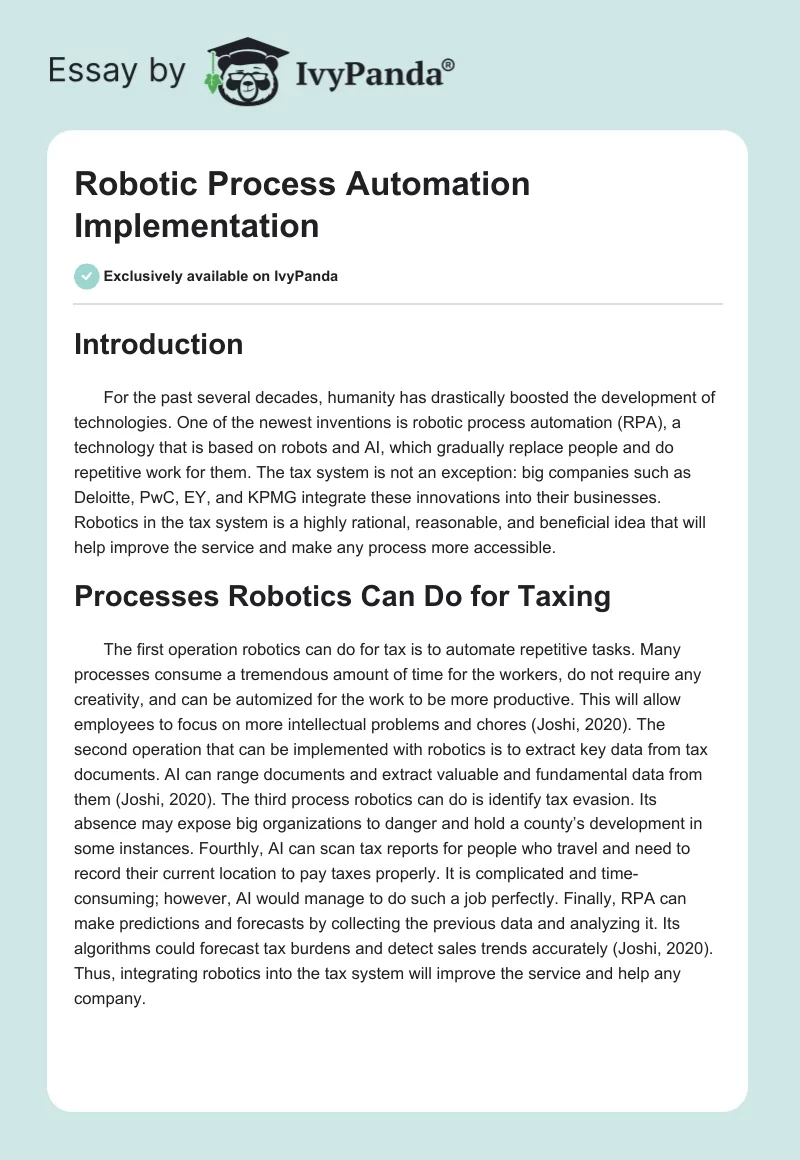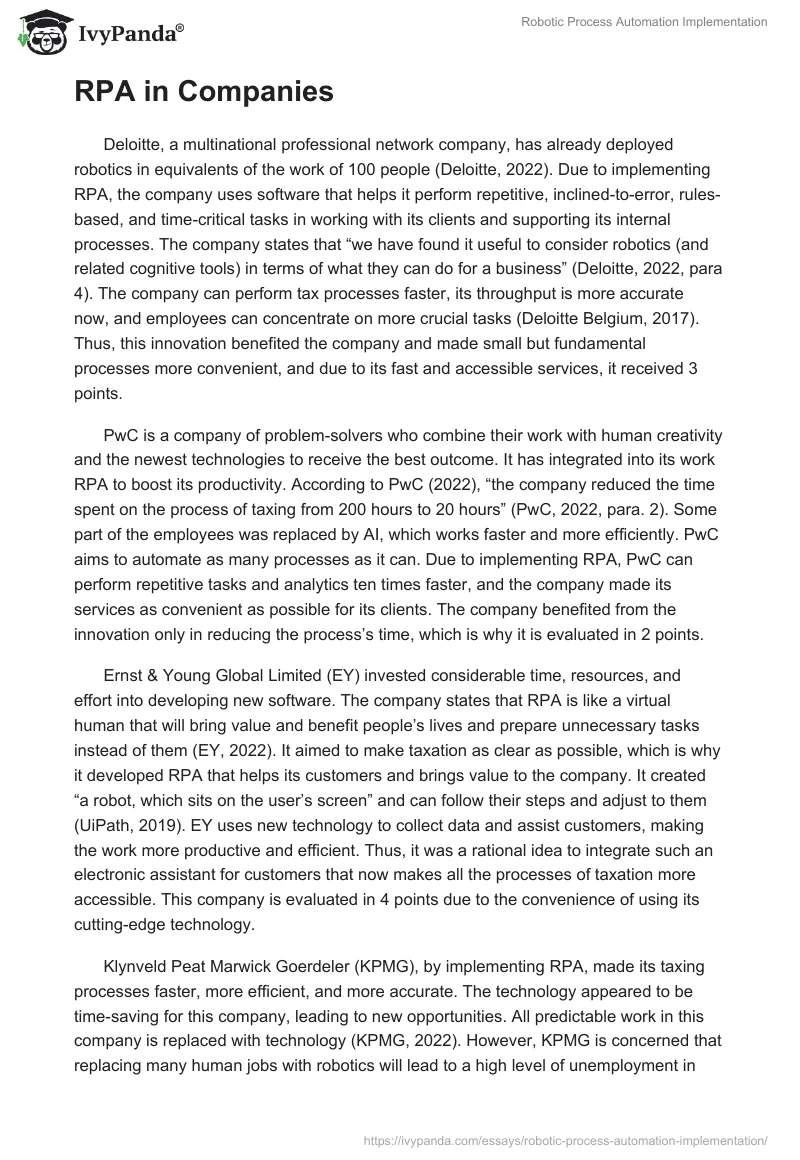Introduction
For the past several decades, humanity has drastically boosted the development of technologies. One of the newest inventions is robotic process automation (RPA), a technology that is based on robots and AI, which gradually replace people and do repetitive work for them. The tax system is not an exception: big companies such as Deloitte, PwC, EY, and KPMG integrate these innovations into their businesses. Robotics in the tax system is a highly rational, reasonable, and beneficial idea that will help improve the service and make any process more accessible.
Processes Robotics Can Do for Taxing
The first operation robotics can do for tax is to automate repetitive tasks. Many processes consume a tremendous amount of time for the workers, do not require any creativity, and can be automized for the work to be more productive. This will allow employees to focus on more intellectual problems and chores (Joshi, 2020). The second operation that can be implemented with robotics is to extract key data from tax documents. AI can range documents and extract valuable and fundamental data from them (Joshi, 2020). The third process robotics can do is identify tax evasion. Its absence may expose big organizations to danger and hold a county’s development in some instances. Fourthly, AI can scan tax reports for people who travel and need to record their current location to pay taxes properly. It is complicated and time-consuming; however, AI would manage to do such a job perfectly. Finally, RPA can make predictions and forecasts by collecting the previous data and analyzing it. Its algorithms could forecast tax burdens and detect sales trends accurately (Joshi, 2020). Thus, integrating robotics into the tax system will improve the service and help any company.
RPA in Companies
Deloitte, a multinational professional network company, has already deployed robotics in equivalents of the work of 100 people (Deloitte, 2022). Due to implementing RPA, the company uses software that helps it perform repetitive, inclined-to-error, rules-based, and time-critical tasks in working with its clients and supporting its internal processes. The company states that “we have found it useful to consider robotics (and related cognitive tools) in terms of what they can do for a business” (Deloitte, 2022, para 4). The company can perform tax processes faster, its throughput is more accurate now, and employees can concentrate on more crucial tasks (Deloitte Belgium, 2017). Thus, this innovation benefited the company and made small but fundamental processes more convenient, and due to its fast and accessible services, it received 3 points.
PwC is a company of problem-solvers who combine their work with human creativity and the newest technologies to receive the best outcome. It has integrated into its work RPA to boost its productivity. According to PwC (2022), “the company reduced the time spent on the process of taxing from 200 hours to 20 hours” (PwC, 2022, para. 2). Some part of the employees was replaced by AI, which works faster and more efficiently. PwC aims to automate as many processes as it can. Due to implementing RPA, PwC can perform repetitive tasks and analytics ten times faster, and the company made its services as convenient as possible for its clients. The company benefited from the innovation only in reducing the process’s time, which is why it is evaluated in 2 points.
Ernst & Young Global Limited (EY) invested considerable time, resources, and effort into developing new software. The company states that RPA is like a virtual human that will bring value and benefit people’s lives and prepare unnecessary tasks instead of them (EY, 2022). It aimed to make taxation as clear as possible, which is why it developed RPA that helps its customers and brings value to the company. It created “a robot, which sits on the user’s screen” and can follow their steps and adjust to them (UiPath, 2019). EY uses new technology to collect data and assist customers, making the work more productive and efficient. Thus, it was a rational idea to integrate such an electronic assistant for customers that now makes all the processes of taxation more accessible. This company is evaluated in 4 points due to the convenience of using its cutting-edge technology.
Klynveld Peat Marwick Goerdeler (KPMG), by implementing RPA, made its taxing processes faster, more efficient, and more accurate. The technology appeared to be time-saving for this company, leading to new opportunities. All predictable work in this company is replaced with technology (KPMG, 2022). However, KPMG is concerned that replacing many human jobs with robotics will lead to a high level of unemployment in Japan. That is why the company is careful with implementing RPA fully. It did not make drastic changes in its process of working using RPA due to its worries about the further economic situation in the country; for this reason, KPMG has received 1 point.
Recommendation
Based on the current research, the top robotics firm is EY due to its cutting-edge innovation of developing an AI that constantly assists users. The company achieved success and has already “reached 100,000 attended bots and 2,000 unattended bots installed globally” (UiPath, 2019). The technology has improved the company’s working processes and already helps its customers. EY has saved time and money due to implementing RPA and achieved a higher level of efficiency and productivity. Furthermore, the best RPA software to use in taxing is UiPath which cooperates with EY due to its effectiveness, level of trust, and success in its work. In terms of software, there are currently four options available from these companies, which are E-file Bot, Tax Adjustment Loader, Tax Portal & Smartview, and Form 8805 (Deloitte US, 2017a; Deloitte US, 2017b; Deloitte US, 2017c). Out of these, I would select the E-file bot because it is essential software that helps automate the process of loading tax-related documentation, storing, and reviewing it for further use. Hence, this software would be used the most frequently.
Conclusion
In conclusion, robotics in the tax system is a highly rational, reasonable, and beneficial idea that will help improve the service and make any process more accessible. It makes work more time-saving and productive, replacing humans with repetitive tasks. Replaced workers can
focus on more creative and intellectual work that AI cannot prepare. Implementing it rationally will bring value to every person and change the economy worldwide.
References
Deloitte US. (2017a). E-file bot [Youtube]. Web.
Deloitte US. (2017b). Tax adjustment loader [Youtube]. Web.
Deloitte US. (2017c). Tax Portal and Smartview[Youtube]. Web.
Deloitte. (2022). “Robotic process automation” Web.
Deloitte Belgium. (2017). Deloitte robotic process automation services. Web.
EY. (2022). “Robotic process automation (RPA)” Web.
Joshi, N. (2020). “How AI and robotics can change taxation.” Forbes. Web.
KPMG. (2022). “Robotic process automation (RPA)” Web.
PwC. (2022). “Creating the tax function of the future: efficient, automated and agile” Web.
UiPath. (2019). “Efficiency without limits: UiPath and EY’s ambitious RPA implementation.” Web.


